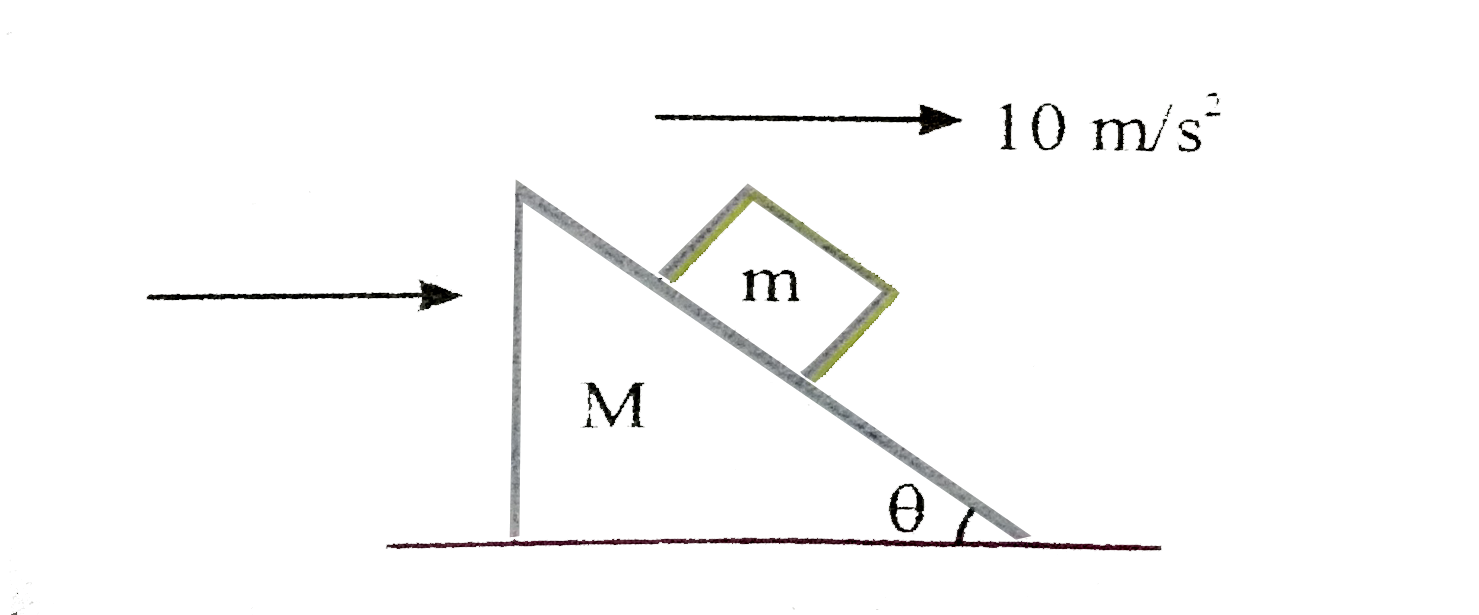In figuer, shown all the surfaces are frictionless, and mass of the block is m=100g. The block and the wedge are held initially at rest. Now the wedge is given a horizontal acceleration of 10ms−2 by applying a force on the wedge, so that the block does not slip on the wedge. Then find the work done in joules by the normal force in ground frame on the block in 1s.

5J
2J
10J
15J
The correct Answer is:A
If block does not slip then, a=gtanθ
⇒10=10tanθ⇒θ=45∘

Nsinθ=ma⇒N×1√2=0.1×10⇒N=√2N
S=12×at2=12×10(1)2=5m
WN=NScosθ=√2×5×1/√2=5J
Alternatively: WN=12mv2=12(0.1)(at)2=5J
Topper's Solved these Questions
- WORK, POWER & ENERGYBOOK - CENGAGE PHYSICSCHAPTER - WORK, POWER & ENERGYEXERCISE - Archives (sinble Correct )
19 Videos
- WORK, POWER & ENERGYBOOK - CENGAGE PHYSICSCHAPTER - WORK, POWER & ENERGYEXERCISE - Archives(multiple Correct)
3 Videos
- WORK, POWER & ENERGYBOOK - CENGAGE PHYSICSCHAPTER - WORK, POWER & ENERGYEXERCISE - Linked Comprehension
55 Videos
- VECTORSBOOK - CENGAGE PHYSICSCHAPTER - VECTORSEXERCISE - Exercise Multiple Correct
5 Videos
Similar Questions
Knowledge Check
In the figure shown all the surfaces are frictionless, and mass of the block 'm' is 1 kg. The block and wedge are held initially at rest. Now wedge is given a horizontal acceleration of 5ms2 by applying a force on the wedge, so that the block does not slip on the wedge. Then work done by the normal force in ground frame on the block in 2 sec is :
(##NAR_NEET_PHY_XI_P2_C06_E09_012_Q01.png" width="80%">A30 JB50 JC100 JD150 JIn the figure shown all the surfaces are frictionless and mass of block m=1kg, block and wedge are held initially at rest, now wedge is given a horizontal acceleration of 10m/s2 by applying a force on the wedge so that the block does not slip on the wedge, the work done by normal force in ground frame on the block in √3sec is
 .A30 JB60 JC150 JD100√3J
.A30 JB60 JC150 JD100√3JA block of mass m is placed on a smooth wedge of wedge angle θ The whole system is accelerated horizontally so that the block does not slip on the wedge. The force (normal reaction) exerted by the wedge on the block has a magnitude:
AmgtanθBmgcosθCmgDmgcosθ
A wedge with mass M rests on a frictionless horizontal surface A block with mass m is placed on the wedge. There is no friction between the block and the wedge. A horizontal force f is applied to the wedge. What magnitude F must have if the block is to remain at constant height above the table top?

View SolutionA block of mass m is placed on a smooth wedge of inclination θ. The whole system is accelerated horizontally, so that the block does not slip on the wedge. The force exerted by the wedge on the block (g is acceleration due to gravity) will be
View SolutionAs shown in the figure a block of mass 'm' is placed on a smooth wedge moving with constant acceleration such that block does not move with respect to the wedge. Find work done by the net force on the block in time t. (Initial speed is 0)

View SolutionA block of mass m is placed on a smooth wedge of incination θ. The whole system s acelerated horizontally so tht the block does not slip on the wedge. The force exerted by the wedge on the block has a magnitude
View SolutionA block of mass m is placed on a smooth wedge of inclination θ & mass M. The whole system is slip on the wedge. Then the normal reaction on the wedge acting from the ground :
View Solution


